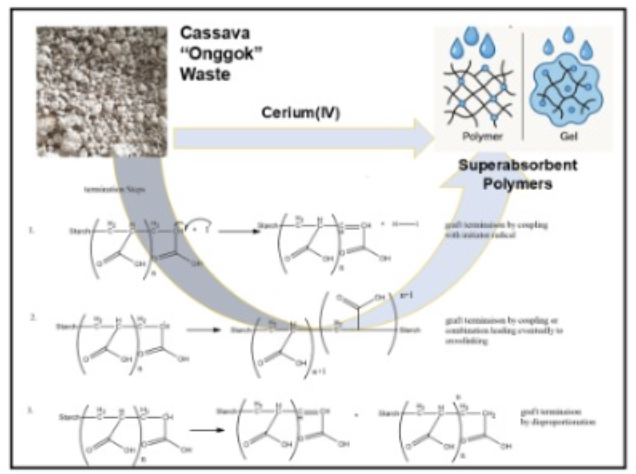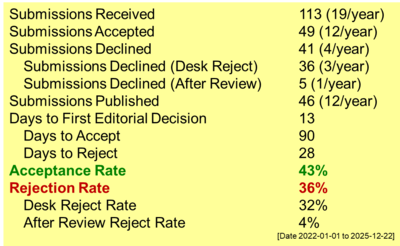Copolymerization of Tapioca Starch Waste through Grafting of Acrylic Acid Monomer with Cerium(IV) Initiator as Super Absorbent Polymer (SAP) Candidate
DOI:
https://doi.org/10.55749/ijcs.v4i2.81Keywords:
Acrylic acid, Cassava onggok waste, Cerium(IV), Graft copolymerization, Superabsorbent polymerAbstract
Indonesia, one of the world's largest tapioca starch producers, generates abundant cassava starch waste (onggok) that remains underutilized. This study aimed to enhance the value of onggok by synthesizing a superabsorbent polymer (SAP) through graft copolymerization using acrylic acid monomer and cerium(IV) initiator. Grafting was optimized by varying monomer concentrations (10–40% w/w) while maintaining the initiator concentration at 1.70% (w/w) and a reaction temperature of 53 °C. The optimal grafting occurred at 20% monomer concentration, yielding a grafting percentage of 14.83% and a monomer conversion of 74.15%. FTIR analysis showed increased absorbance ratios of –OH to C=O functional groups, confirming successful grafting. SEM images revealed a transformation from granular to porous structures, while DSC analysis demonstrated a shift in gelatinization temperature from 45.91 °C (raw onggok) to 46.69 °C (grafted), and retrogradation temperature from 140.67 °C to 141.67 °C. The water absorption capacity of the grafted copolymer reached 4.2450 g/g (5.20 g total), nearly double that of raw onggok (2.2716 g/g or 3.20 g), confirming its effectiveness as a SAP material.
References
[1] Soeprijanto, S., Qomariyah, L., Hamzah, A., & Altway, S. 2022. Bioconversion of industrial cassava solid waste (onggok) to bioethanol using a saccharification and fermentation process. Int. J. Renew. Energy Dev. 11(2). 357. doi: https://doi.org/10.14710/ijred.2022.41332
[2] Matmin, J., Ibrahim, S.I., Mohd Hatta, M.H., Ricky Marzuki, R., Jumbri, K., & Nik Malek, N.A.N. 2023. Starch-derived superabsorbent polymer in remediation of solid waste sludge based on water-polymer interaction. Polymers (Basel). 15(6). 1471. doi: https://doi.org/10.3390/polym15061471
[3] Garcia-Valdez, O., Champagne, P., & Cunningham, M.F. 2018. Graft modification of natural polysaccharides via reversible deactivation radical polymerization. Prog. Polym. Sci. 76. 151–173. doi: https://doi.org/10.1016/j.progpolymsci.2017.08.001
[4] Cheng, S., Zhao, Y., & Wu, Y. 2018. Surfactant-free hybrid latexes from enzymatically hydrolyzed starch and poly (butyl acrylate-methyl methacrylate) for paper coating. Prog. Org. Coatings. 118. 40–47. doi: 10.1016/j.porgcoat.2018.01.015
[5] Singh, S. 2016. Cerium oxide based nanozymes: Redox phenomenon at biointerfaces. Biointerphases. 11(4). 04B202. doi: https://doi.org/10.1116/1.4966535
[6] Noordergraaf, I.W., Witono, J.R. and Heeres, H.J. 2024. Grafting starch with acrylic acid and Fenton’s initiator: The selectivity challenge. Polymers. 16(2). 255. doi: https://doi.org/10.3390/polym16020255
[7] Butruk-Raszeja, B.A., Trzaskowska, P.A., Kuźminska, A., & Ciach, T. 2016. Polyurethane modification with acrylic acid by Ce (IV)-initiated graft polymerization. Open Chem. 14(1). 206–214. doi: https://doi.org/10.1515/chem-2016-0020
[8] Rodič, P., Korošec, R.C., Kapun, B., Mertelj, A. and Milošev, I. 2020. Acrylate-based hybrid sol-gel coating for corrosion protection of AA7075-T6 in aircraft applications: The effect of copolymerization time. Polymers. 12(4). 948. doi: https://doi.org/10.3390/polym12040948
[9] Banerji, K.K., 2020. Oxidation and Reduction. Organic Reaction Mechanisms· 2016: An annual survey covering the literature dated January to December 2016. 97-199. doi: https://doi.org/10.1002/9781119288657.ch3
[10] Nair, V. and Deepthi, A., 2007. Cerium (IV) ammonium nitrate a versatile single-electron oxidant. Chem. Rev. 107(5). 1862-1891. doi: https://doi.org/10.1021/cr068408n
[11] Chen, Y., Xu, H., Ma, Y., Liu, J. and Zhang, L. 2022. Diffusion of polymer-grafted nanoparticles with dynamical fluctuations in unentangled polymer melts. Phys. Chem. Chem. Phys. 24(18). 11322-11335. doi: https://doi.org/10.1039/D2CP00002D
[12] Chen, Y., Chen, Y., Xiang, Z., Liang, J., Liu, L. and Liu, J. 2025. Diffusion of Polymer-Grafted Nanoparticles with Arm Retraction in Entangled Polymer Melts. Macromolecules. 58(18). 9586–9595. doi: https://doi.org/10.1021/acs.macromol.5c01345
[13] Gallardo, A.K.R., Silos, A.P., Relleve, L.S. and Abad, L.V. 2022. Retrogradation in radiation-synthesized cassava starch/acrylic acid super water absorbent and its effect on gel stability. Radiat. Phys. Chem. 199. 110313. doi: https://doi.org/10.1016/j.radphyschem.2022.110313
[14] Puspita, I., Kurniati, M., Winarti, C. and Maddu, A. 2023. Superabsorbent hydrogel from cassava waste pulp–acrylamide–acrylic acid to increase water holding capacity in sandy soils. IOP Conf. Ser.: Earth Environ. Sci. 1267(1). 012088. doi: https://doi.org/10.1088/1755-1315/1267/1/012088

Downloads
Published
How to Cite
Issue
Section
License
Copyright (c) 2025 Indonesian Journal of Chemical Studies

This work is licensed under a Creative Commons Attribution-ShareAlike 4.0 International License.






















